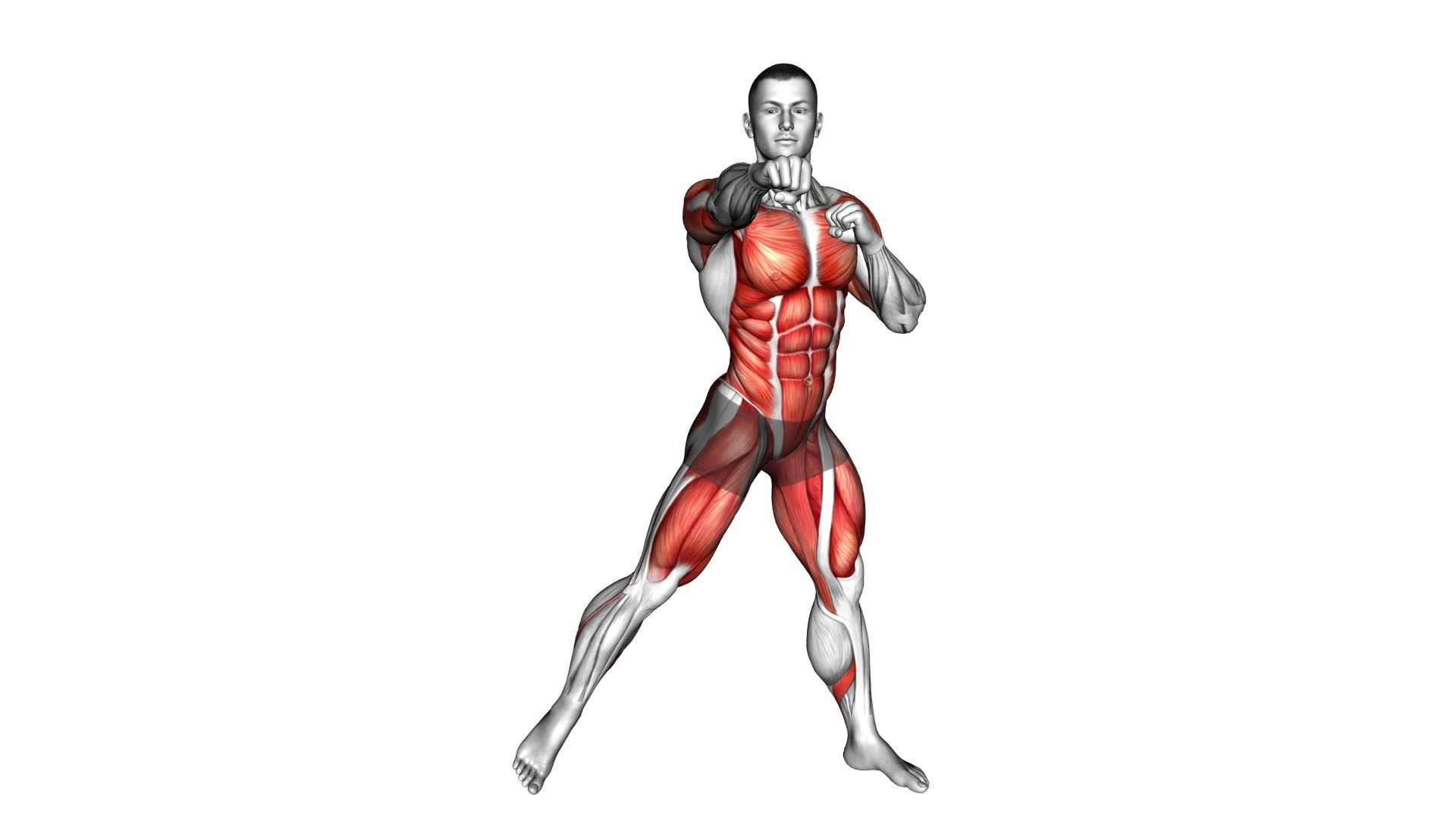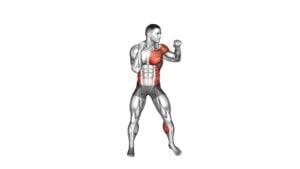Squat Side-up Hook Punch (male) – Video Exercise Guide & Tips

Get ready to amp up your workout with the Squat Side-up Hook Punch.
Watch This Exercise Video
This video exercise guide and tips will help you master this powerful move. Learn the proper technique, avoid common mistakes, and discover tips to maximize its effectiveness.
With variations and modifications available, you can tailor this exercise to your fitness level. Get ready to sweat and build strength with the Squat Side-up Hook Punch.
Let's get started!
Key Takeaways
- The Squat Side-up Hook Punch improves upper body strength and rotational power.
- It targets multiple muscle groups including the shoulders, chest, back, and arms.
- The exercise engages core muscles, particularly the obliques, for rotational power.
- Proper technique involves maintaining a stable base, engaging the core throughout, and focusing on precision rather than rushing the movement.
Benefits of the Squat Side-up Hook Punch
Benefit from the Squat Side-up Hook Punch to improve your upper body strength and rotational power. This exercise is highly effective for improving power and targeting multiple muscle groups. The Squat Side-up Hook Punch primarily focuses on the muscles in your upper body, including your shoulders, chest, back, and arms. By performing this exercise, you can enhance the strength and definition of these muscles.
The Squat Side-up Hook Punch involves a combination of squatting and delivering a hook punch while rotating your torso. This movement engages your core muscles, especially your obliques, as they play a crucial role in generating rotational power. Additionally, as you squat, you activate your leg muscles, such as your quadriceps and glutes, which provide stability and power during the punch.
Proper Technique for the Squat Side-Up Hook Punch
To perform the Squat Side-Up Hook Punch with proper technique, you need to start from the standing position. Begin by standing with your feet shoulder-width apart and your knees slightly bent. This squat position provides a stable base for generating power and balance during the punch.
As you initiate the punch, rotate your hips and shoulders simultaneously in the direction of the punch. This rotational movement generates power and adds force to your punch. Keep your core engaged and your back straight throughout the movement to maintain stability and prevent injury.
As you squat down, shift your weight onto your back leg while keeping your front foot firmly planted on the ground. This weight transfer helps generate power and stability for the punch.
As you come up from the squat position, drive your back leg forward and rotate your body, pivoting on the ball of your back foot. This movement allows you to generate maximum power and torque for an effective hook punch.
Remember to keep your arm relaxed until the moment of impact. At that point, tighten your fist and aim for the target, directing the punch with the knuckles of your index and middle fingers.
Common Mistakes to Avoid During the Squat Side-Up Hook Punch
To avoid common mistakes during the Squat Side-Up Hook Punch, make sure to focus on maintaining proper form and technique.
One common mistake isn't maintaining a stable base during the squat. It's crucial to keep your feet shoulder-width apart and your knees in line with your toes.
Another mistake to avoid isn't keeping your core engaged throughout the movement. This helps to stabilize your body and generate power.
Additionally, be mindful of not leaning too far forward or backward during the punch. This can throw off your balance and reduce the effectiveness of the punch.
Another common mistake isn't fully extending your arm during the hook punch. Make sure to fully extend your arm towards your target and follow through with your punch.
Finally, avoid rushing the movement. Take your time to perform the exercise correctly and focus on executing each step with precision.
Tips to Increase the Effectiveness of the Squat Side-Up Hook Punch
To maximize the effectiveness of your Squat Side-Up Hook Punch, focus on performing the exercise with proper form and engaging your core throughout. Here are some tips to help you increase the power and improve the accuracy of your punch:
- Generate power from the legs: As you squat down, make sure to push through your heels and explode up using the power from your legs. This will help you generate more force in your punch.
- Rotate your hips and shoulders: To increase the power and accuracy of your punch, focus on rotating your hips and shoulders in the direction of your punch. This will add more momentum and force to your strike.
- Practice hand-eye coordination: Accuracy is essential in any punch. To improve your accuracy, incorporate drills that focus on hand-eye coordination. Use a target, such as a punching bag or focus mitts, and work on hitting specific spots consistently.
Modifications and Variations for the Squat Side-Up Hook Punch
To modify and vary the Squat Side-Up Hook Punch, try incorporating different angles and heights to target specific muscle groups and challenge your body in new ways.
One option is to explore alternative punches for the squat side-up position. Instead of the hook punch, you can try throwing uppercuts or straight punches. Uppercuts focus on targeting the core and upper body muscles, while straight punches engage the chest, shoulders, and triceps. By incorporating these alternative punches, you can add variety to your workout routine and work different muscle groups.
Another way to modify the Squat Side-Up Hook Punch is by adjusting your squat stance. Instead of a traditional squat stance, you can try a wider stance to engage your glutes and inner thighs more. This modification won't only target different muscles but also challenge your balance and stability. Alternatively, you can try a narrower stance to emphasize your quads and outer thighs. Experimenting with different squat stances will help you target specific muscle groups and keep your workout routine interesting.
Remember to always maintain proper form and technique when modifying the Squat Side-Up Hook Punch. Start with lighter weights or resistance bands if you're new to these modifications, and gradually increase the intensity as you become more comfortable.
Incorporating these modifications and variations won't only challenge your body in new ways but also help you prevent plateaus and continue progressing towards your fitness goals.
Frequently Asked Questions
What Are the Benefits of Incorporating the Squat Side-Up Hook Punch Into My Workout Routine?
Incorporating the squat side-up hook punch into your workout routine has numerous benefits. This exercise helps to strengthen your lower body, specifically your quadriceps, glutes, and hamstrings. It also engages your core muscles for stability and balance.
Additionally, the squat side-up hook punch improves your upper body strength and coordination by targeting your shoulders, arms, and back. To perform this exercise properly, ensure that you maintain proper form and technique throughout the movement.
Are There Any Specific Techniques or Form Cues That Can Help Me Perform the Squat Side-Up Hook Punch Correctly?
To perform the squat side-up hook punch correctly, there are a few techniques and form cues you should keep in mind.
First, make sure to engage your core and maintain proper posture throughout the movement.
Keep your feet shoulder-width apart and bend your knees into a squat position.
As you come up, rotate your hips and pivot on the balls of your feet while throwing a hook punch with your lead hand.
Avoid leaning forward or overextending your punches, as these are common mistakes.
What Are Some Common Mistakes That Beginners Make When Attempting the Squat Side-Up Hook Punch, and How Can I Avoid Them?
When attempting the squat side-up hook punch, beginners often make some common mistakes. To avoid these errors, it's crucial to maintain proper form and technique.
One mistake isn't squatting low enough, which can reduce the power of the punch.
Another mistake is neglecting to pivot on the back foot, resulting in a weaker hook.
Do You Have Any Tips or Recommendations to Maximize the Effectiveness of the Squat Side-Up Hook Punch?
To maximize the effectiveness of the squat side-up hook punch, here are some tips and recommendations.
First, focus on your form and technique, ensuring that your punches are executed with proper alignment and power.
Second, engage your core muscles and maintain a stable base by keeping your feet planted firmly on the ground.
Lastly, practice regularly and gradually increase the intensity and speed of your punches over time.
Can You Suggest Any Modifications or Variations of the Squat Side-Up Hook Punch for Individuals With Different Fitness Levels or Limitations?
If you're looking for modifications or variations of the squat side-up hook punch, there are a few options.
For individuals with limited fitness levels, you can start by performing the exercise without any weights and gradually increase the intensity.
If you have limitations, like joint issues, you can try performing the exercise with resistance bands instead of weights.
Remember to always listen to your body and adjust the exercise to your fitness level and capabilities.
Conclusion
The squat side-up hook punch is a powerful exercise that targets the upper body and core muscles. By using proper technique and avoiding common mistakes, you can maximize the effectiveness of this exercise. Remember to engage your core, rotate your hips, and keep your body balanced throughout the movement.
With practice, you can increase the power and strength of your hook punch. Don't forget to consult with a trainer or fitness professional for personalized modifications and variations.
Keep punching!

Author
Years ago, the spark of my life’s passion ignited in my mind the moment I stepped into the local gym for the first time. The inaugural bead of perspiration, the initial endeavor, the very first surge of endorphins, and a sense of pride that washed over me post-workout marked the beginning of my deep-seated interest in strength sports, fitness, and sports nutrition. This very curiosity blossomed rapidly into a profound fascination, propelling me to earn a Master’s degree in Physical Education from the Academy of Physical Education in Krakow, followed by a Sports Manager diploma from the Jagiellonian University. My journey of growth led me to gain more specialized qualifications, such as being a certified personal trainer with a focus on sports dietetics, a lifeguard, and an instructor for wellness and corrective gymnastics. Theoretical knowledge paired seamlessly with practical experience, reinforcing my belief that the transformation of individuals under my guidance was also a reflection of my personal growth. This belief holds true even today. Each day, I strive to push the boundaries and explore new realms. These realms gently elevate me to greater heights. The unique combination of passion for my field and the continuous quest for growth fuels my drive to break new ground.







